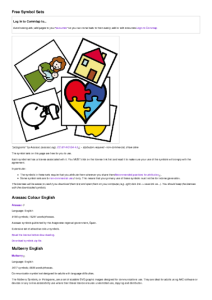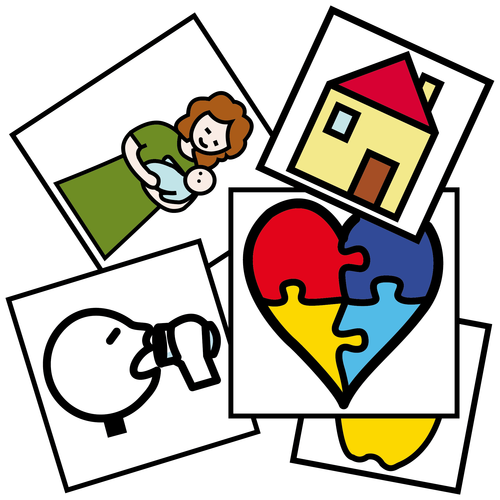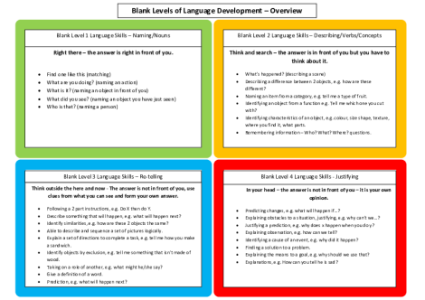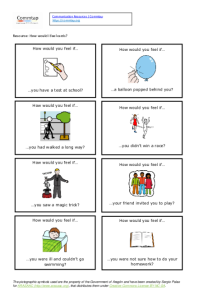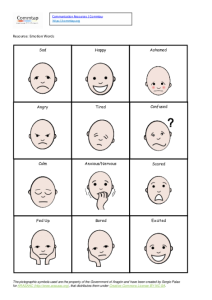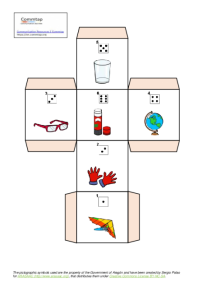Search
User login
Topic “Higher level/abstract language”
Activities to develop understanding of instructions containing 2 key words - set 2 (noun + verb)
| Activity/strategy name and materials required | How to do the activity | Key principles for doing the activity and comments |
|---|---|---|
| Actions Game - works on object + action (noun + verb) - 2 different soft toys | 1. Print and cut out the action cards - you could draw some actions if you do not have access to a printer. 2. Show your child the actions and say the word - practice making both soft toys carry out the actions. 3. When you are sure your child understands the different action words, start to give your child instructions, e.g. make teddy fly, make dolly sleep. 4. After a few turns see if your child can give you an instruction. | To increase complexity, click here for activities focusing on three key word instructions. (Add link) |
understand why questions in context and respond
| Activity/strategy name and materials required | How to do the activity | Key principles for doing the activity and comments |
|---|---|---|
| The Disastrous Day A Playmobil figure or similar Small world objects - some of them broken | 1. Explain that you are going to tell a story about the toy. 2. Tell a story about what the toy does in the day. Lots of things go wrong because the objects are broken e.g. 'want to go to work in the car but it won't move.' 3. Whenever there is a problem for the toy, ask the child 'why?' e.g. 'why won't the car move?' Answer: 'because there is no wheel!' | Give the child a turn at telling the story too. |
| Freddy's Travels A toy character (called Freddy) Pictures of different locations, e.g. beach, mountains One or two items which go with each location e.g. bucket and swimming costume for the beach | ||
| Animal Adventure Pictures of different locations with different 'hazards' or things of interest e.g. a jungle with a river and dinosaurs Two toy animals (wind up toys are ideal) | Use your imagination! | |
| Problem solving Equipment to demonstrate an everyday problem and discuss it. Some examples of equipment you could use: Torch or toy with no batteries; Cup with a hole in it; Dry pasta; Pen with no nib and in; Broken pencil; Dry pen with no lid. | You will need to think of a problem in advance - see the list in the materials column. This activity is ideal to do throughout the child's day, whenever there is a problem to be solved! |
Developing the skills to understand and express different emotions
| Activity/strategy name and materials required | How to do the activity | Key principles for doing the activity and comments |
|---|---|---|
| Talking about different emotions - Photographs of different people showing different emotions - you could get these from magazines, newspapers or by internet search. - Emotion symbols - click here to print. - Paper and pens | 1. Look through the photographs together - talk about what feelings or emotions the person is showing - you may have different answers from each other. Talk about why they may be showing emotions. 2. Can you match the symbols to the emotions. Talk about the differences you notice in peoples' faces. 3. Can you think of times when you felt this emotion - use the paper and pens to write this down. Compare your experiences. | You may want to start with basic emotion words such as happy, sad, cross and excited, before introducing more complex emotion words. |
| Feeling Dictionary - Exercise book/note pad/sheets of paper - Emotion symbols - click here to print. You can draw your own if you prefer. | Definitions: Happy: This is when I feel good about something. I might smile or laugh. Sad: This is when I don't feel good about something. I might cry. I might show I feel this way by being cross. Angry / cross: This is what I feel when something is not fair, or is bad. I might feel like shouting or punching or doing something to someone. Bored: This is when I'm not interested in what is happening, and just want it to finish. I might sigh, or lean my head on my hand. Upset: I might feel like this when something is not fair, or when someone is unkind. I might cry, or feel like shouting. Frightened / scared: This is what I might feel if I don't know what is happening, or if I am unsafe. I might cry, or scream, or just try not to move. I might want to find someone I know, like my mum or my teacher. Surprised: this is what I feel when something good happens that I didn't expect. I might smile, open my eyes wide, and say something like 'wow'! Excited: This is what I feel when I know something good is going to happen soon. I might smile, move around, and keep thinking about what is going to happen. | |
| If you're happy and you know it... - Emotion symbols (click here to print)or feelings Dictionary (see above) - Time-line of a day | You could choose a different feeling each day to work through the timeline. You could also display the timeline, and encourage the child / children to identify how they are feeling at different parts of the day. |
Say how you would feel in situations
| Activity/strategy name and materials required | How to do the activity | Key principles for doing the activity and comments |
|---|---|---|
| How would you feel if?: - Pictures/photos of different emotions - a printable set of emotion cards are available here. | 1. Print and cut out the resources. 2. Introduce the activity by having a quick discussion of how it's fine if different people feel differently about the same situation. 3. Take turns to choose a situation card and discuss it together. See if you can match how you would feel to the emotions symbols or pictures. 4. Some children may be able to explain why they'd feel that way e.g. "I'd be scared if I saw a spider because I don't like them'. | Reinforce the idea that there's no 'right' answer. |
Support Commtap to keep it online
Thank you for visiting Commtap.
Please read this message as it is extremely important.
- Visitor donations mean we can continue to host over 1,000 free activities to support speech, language, and communication development.
- Visitor donations mean we can continue to provide free resources to address a wide range of communication needs, including limited speech or language, interaction challenges, and needs associated with conditions such as developmental language disorder, autism, and cerebral palsy.
- Visitor donations mean we can continue to provide resources to support the work of speech and language therapists, teachers, teaching assistants, parents, and carers.
- Visitor donations mean we can continue to provide the free key word sign dictionary (bks.org.uk) which has over 2,000 Makaton and Signalong signs.
We know that not everyone is able to afford to pay to access these resources, however, if you can, please make a donation to keep the site going.
Thank you
Google ads on this page are provided by Google Adsense - and their presence does not imply any endorsement by Commtap. Report a problem with an ad on this page. Log in (for free) to avoid seeing Google ads.
